
| |
|
This
is the 1997 Nesquehoning Calendar
|
|
Cover |
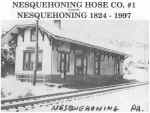
|
Click on pictures to enlarge and click your back
button to return.
|
|
January |

|
|
|
The Eagle Hotel was built by Andrew McCabe in 1842. When
this photo was taken, Patrick J. McMahon owned the building, He was born
in County Cavan, Ireland on October 10, 1861. His family moved to
Nesquehoning in 1863. At the age of nine year, Patrick began life as a
slate picker in the Nesquehoning breaker. At the age of eighteen, he
went to Providence Rhode Island, where he learned the trade of a
carpenter, which he pursued until 1896 when he purchased one of the
town's best known landmarks - the Eagle Hotel. He refitted and
modernized the hotel, making it one of the most homelike and popular hostelries
in the area. He also built many of the homes in Nesquehoning, including
the Sacred Heart Parish rectory. On the second floor veranda are Alice
McDermott and Nesquehoning school teacher Sally Cadden. Men standing on
the porch are Frank Duffy, Patty Dolan and Patrick McMahon. The building
was destroyed by a fire on May 8, 1977. This is the present site of
Turkey Hill Mini Mart.
|
|
February |

|
|
|
The first discovery of coal was at Nesquehoning in 1786.
This photo shows room Run Tunnel #1. It was the first true tunnel at
Nesquehoning, driven by Charles Ashley on contract to Packer and Harlan
in 1843. The first mines at Nesquehoning were called drifts, driven
along the thrust of the coal seams. In a manager's report dated Dec. 30,
1830, Josiah White estimated that "allowing our demand to be one
million tons each year from these mines, one mile would last more than
fifty-five years. The same report included remarks by Dr. Silliman who
stated that the coal "appears to be of the first quality, and in
the high lustre and perfection of its fracture, exceeds anything I have
elsewhere seen." Dr. Silliman also did not hesitate to call the new
mines "entirely inexhaustible."
|
|
March |

|
|
|
Bill Kissner, Hugo Diehl, Joe Kmetz and others from Hauto
decided to start a fire company. They bought a house from McManus and
used it until they raised enough money to build a new building. The girl
shown in this July 1963 picture is Barbara Kmetz
|
|
April |
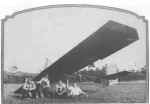
|
|
|
Nesquehoning bottler does high flying advertising.
Lettering on tail wing reads - Drink McFadden Beverages. McFadden's
Quality Beverage Co. was located at the corner of Catawissa and Almond
Sts. They made, bottled and sold soda in a variety of flavors. Their
lemon soda was put in special green bottles and was called Sally Ann.
The business was later sold to the Vaiana family, and they made soda
into the 1960's. The date of this photo is August 14, 1932. Jack
McFadden is second from the left.
|
|
May |

|
|
|
On October 10, 1868 the Lehigh Coal and Navigation
Company advertised for proposals to erect a new breaker at Nesquehoning.
Less that a year later, on August 6, 1869, this new double breaker
"with all the modern improvements for screening and preparing
coal" was in service. this photo was taken on May 31, 1885.
In 1886, a year after this picture was taken it started on fire and
burned to the ground. On September 11, 1869 monthly wages were - slate
pickers $4.00 - door boys $6.00 - drivers $12.50 - laborers $14.00 -
bottom men $15.00. Married men paid 75 cents monthly to the resident
surgeon, who supplied all medicines and supplies during any case of
illness.
|
|
June |

|
|
|
This 1948 photo of the Nesquehoning athletic field was
taken from the roof of the high school. The building on the left was the
field house where players would get dressed and take showers. In the
1930's the government started various programs to give jobs to the
unemployed. One was N.Y.A. - National Youth Administration. People would
work forty hours a month and get paid fourteen dollars. The Nesquehoning
athletic field was built under this program. They built the field house,
planted trees and hedges, and made a running track around the field
using red cinders. The field was resodded three layers thick, two layers
of sod were laced upside down and the third layer was right side
up.
|
|
July |

|
|
|
This is a picture of Kattner's coal trucks parked on west
Railroad Street back in the 1920's.
|
|
August |
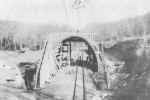
|
|
|
In 1953 the Broad Mt. road was described as a "Death
Trap." The dangers of the winding highway on the south side of the
Broad Mt. - re-emphasized frequently by deaths and near deaths at the
Shady Rest curve. In 1956 construction was started on a new highway.
This photo shows construction of the train tunnel that goes under Rt.
93.
|
|
September |

|
|
|
This photo is of a parade held on September 26, 1953.
Nesquehoning residents were asked to bring out flags and bunting and
other ornaments of festive array for the mammoth parade and dedicatory
program. This was the biggest celebration ever held in the Panther
Valley. It was for the dedication of the Green plant in Nesquehoning.
The new industry will employ 375 workers in the manufacture of stainless
steel equipment for use in hospitals. Governor John S. Fine and other
high national, state and county officials were present ass well as
famous TV vocalist Teresa Brewer. The governor lauded the initiative of
the Nesquehoning Improvement Association in bringing the new industry to
the area. "This new plant is an economic boom to the direly
distressed area. Nesquehoning is the progressive hub of Carbon County
dedicated to advancement, a small mining town which in recent years has
made tremendous steps forward in the direction of community betterment,
establishing a commendable record of achievement which is without
parallel for a town its size in Pennsylvania." Joseph Greco,
Esquire was the prime mover in bringing the Green plant to Nesquehoning.
Lengyel's service station is at the left. The building on the right
contained a hardware store owned by John Kunzweiler and his wife
Elizabeth operated a grocery store. The gas station was run by Bob Taney.
|
|
October |

|
|
|
This turn of the century photo was taken at the
intersection of Railroad, Center and School Sts., also known as the Five
Points. The building on the left had numerous owners. Bill Branch had a
store there, Lou Bechtel ran a restaurant in the place, then Joe Logan
opened up a poolroom and then the Ukrainian Club took over. At the
present time it is Nalesnik's Funeral Home. When the Nesquehoning
schools became overcrowded, buildings at the Five Points were used as classrooms.
The building on the left was used by Bill Thomas to teach industrial
arts. The fifth grade class used the basement in the building on the
right and other classes were held at the Nesquehoning Hose Co. #1.
|
|
November |

|
|
|
Nesquehoning Electronics Baseball Team, 1961. Front row:
Mark Potosky, Bobby Bincarowsky, Jack Figura, Bob McMichael, Milan
Skodacek, Chas Lopresto, Bob Dobosh. Standing: Mike Turrano, Bob Conway,
Mike Kulick, Bob Matula, Denny Creitz, Dave Hunadi, Mike Cerimele, Nino
Logan. Coaches: Len Dietz, Chip Bincarowsky.
|
|
December |

|
|
|
Buss's Hotel in the late 1800's. Jacob Buss, earned his
fame as landlord of Lausanne's Landing Tavern, at the mouth of the
Nesquehoning Creek. In April of 1872 Buss closed up shop at the landing
and relieved James Carrol as landlord of Nesquehoning's Miner's Hotel,
located at the spot now inhabited by the Post Office. This corner
quickly became known as "Buss's Corner". Across Catawissa St.
From Buss's Hotel was G. L. Watson's clothing store, one of the oldest
stands in town. In 1898 Watson's store was taken over by Marks and
Bechtold. In addition to his fame as landlord, Buss was a famous butcher
and rattlesnake killer. He became tax collector of Mauch Chunk Township
in 1878, and was one of the first directors of the Nesquehoning Building
and Loan Association when it was chartered in 1889. One of his sons
Martin G. Buss, was postmaster of Nesquehoning, and took over as
landlord of the Miners Hotel in 1906. Jacob Buss died sometime in 1909
after suffering two paralytic strokes. By 1914 the Miner's Hotel passed
into the hanks of Fritz Ferko, and was no longer known as the Miner's
Hotel. In that year, Ferko constructed a "Nickolette" building
adjacent to the west side of the old hotel.
|
|
Inside Back Cover |

|
|
|
Front row: Bearcat Malaska, Harold Billig, Schmick
Cerimele, George Slivka, Joe Petrovich, Zello Davis, Pete Slivka, Paul
Kucan, Butch Horvath, Al Sommers, George Kusko, Second row: Pete
Stavecki, Perky Priggins, Dick Kuzma, Sam Kutalek, Flash Sterzen, Tony
Stianchie, Jake Maurer, Bill Damian, Bambi Stianchie, Sam Pagano, Jim
Parano, Wash Polohovich.
|
|
Inside Back Cover |
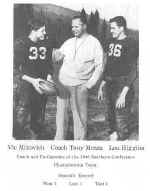
|
|
|
In the early days of our country, the American
Indian keeps records of important individual and tribal events on dried
buffalo skins. These yearly records were known as their Winter Count.
Since we in Nesquehoning are proud of our Indian traditions and
background, we, too, have our own Winter Count. As we glance over this
revered record, we find one name is outstanding - Anthony J. Mezza. For twenty-nine years Mr. Mezza was the astute head football
coach of Nesquehoning High School. This highly-respected coach came to
Nesquehoning from Bucknell University, where he had received statewide
acclaim and recognition in New York State during his high school career
at Rome Free Academy, Rome, New York, where he was a 4-letter man in
athletics and was named to the All-State football team for three
straight years. Mr. Mezza also gained New York All-State recognition in
throwing the shot put. An advocate of the single-wing formation, Mr.
Mezza's teams have an impressive record of victories. He knew football
rules and regulations down to the smallest detail. When he argued a
point with an official, he knew what he was talking about. He believed
in long, rugged practice session to whip his boys into shape, and as a
result his team injuries were remarkably few. Mr. Mezza was strict and
precise in his guidance and demanded obedience from all. His precise and
well-drilled teams looked good even in defeat. He never coached a team
that quit or relaxed on the field. He encouraged a fierce, competitive
spirit; above all, his boys respected and admired him. We will always
remember those hard-fought, exciting games. No one will ever forget his
famous and always popular "offside play," when his entire line
shifted before the ball was passed to draw his opponents offsides to
gain that much needed five yards. The crowds loved this, but many
opposing players down the years will remember how frustrated they felt
as five yard penalty was paced off against them. To win a hard-fought
victory against a Mezza coached team was considered an achievement. Mr.
Mezza also coached the highly rated Nesquehoning Hurricanes, a
semi-professional team of 1946-47-48, which won 32 games against a
single loss. Yes, the Winter Count revives many memories - a memory of
those famous half-time pep talks - a memory of Mr. Mezza, resplendent in
a well-tailored suit and startling cravat, elegant from his broad
shoulders right down to his well-shined shoes striding out on the field
to fight for his players. The Winter Count, has duly recorded our own
respect for his ability and integrity. It has also recorded the warm
place he has won in our hearts
|
|
Back Cover |
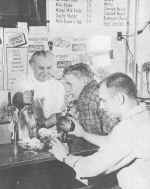
|
|
|
Ed Lucas Varsity Shop from 1938 to 1977. This 1957 photo
shows Ed Lucas, Eddie Kocha and Steve Kusko.
|
|